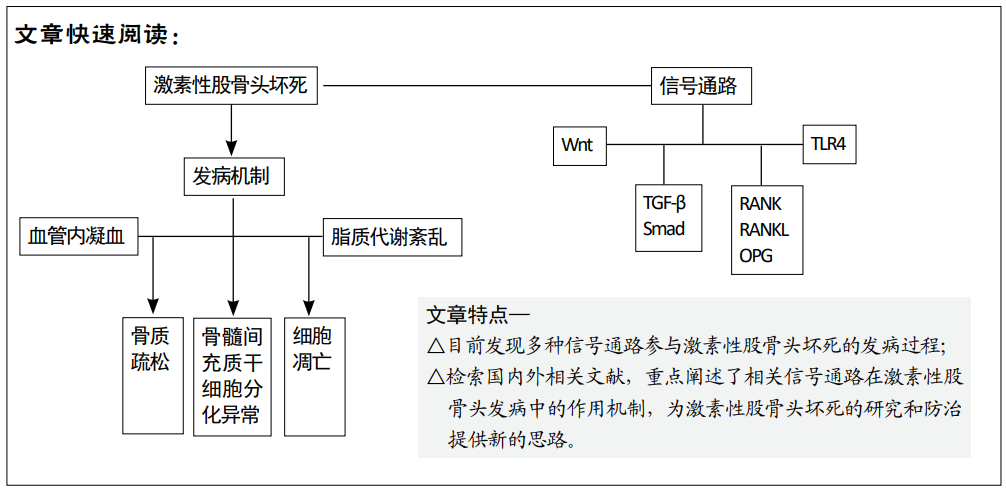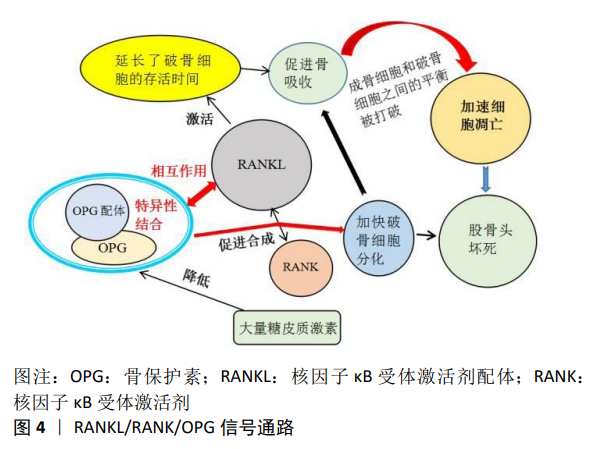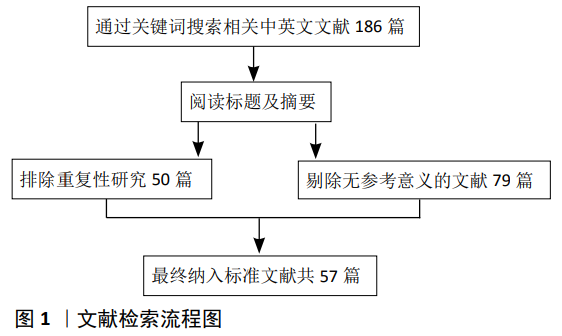[1] ZHANG Y, LIU Y, ZHOU G, et al. Fibular allograft for osteonecrosis prevention in the management of femoral neck fractures: clinical outcome and biomechanical evaluation. J Biomater Tissue Eng. 2015; 5(12):937-941.
[2] 王耀霆,梁豪君,姜川,等. MRI指导下经皮钻孔减压术治疗股骨头缺血性坏死的疗效[J].武警医学,2020,31(2):132-135.
[3] WIN AZ, APARICI CM. Non-traumatic radiation-induced avascular necrosis of the femoral neck. QJM. 2015;108(3):257-258.
[4] GÓMEZ-MONT LANDERRECHE JG, GIL-ORBEZO F, MORALES-DOMINGUEZ H, et al. Nontraumatic causes of bilateral avascular necrosis of the femoral head: link between hepatitis C and pegylated interferon. Acta Ortop Mex. 2015;29(3):172-175.
[5] CHAO PC, CUI MY, LI XA, et al. Correlation between miR-1207-5p expression with steroid-induced necrosis of femoral head and VEGF expression. Eur Rev Med Pharmacol Sci. 2019;23(7):2710-2718.
[6] LI GQ, WANG ZY. MiR-20b promotes osteocyte apoptosis in rats with steroid-induced necrosis of the femoral head through BMP signaling pathway. Eur Rev Med Pharmacol Sci. 2019;23(11):4599-4608.
[7] FANG SH, LI YF, JIANG JR, et al. Relationship of α2-Macroglobulin with steroid-induced femoral head necrosis: a Chinese population-based association study in southeast China. J Orthop Surg. 2019;11(3): 481-486.
[8] WANG A, REN M, WANG J. The pathogenesis of steroid-induced osteonecrosis of the femoral head: a systematic review of the literature. Gene. 2018;671:103-109.
[9] JONES LC, HUNGERFORD DS. Osteonecrosis: etiology, diagnosis, and treatment. Curr Opin Rheumatol. 2004;16(4):443-449.
[10] VAROGA D, DRESCHER W, PUFE M, et al. Differential expression of vascular endothelial growth factor in glucocorticoid-related osteonecrosis of the femoral head. Clin Orthop Relat Res. 2009;467(12): 3273-3282.
[11] LI J, FAN L, YU Z, et al. The effect of deferoxamine on angiogenesis and bone repair in steroid-induced osteonecrosis of rabbit femoral heads. Exp Biol Med (Maywood). 2015;240(2):273-280.
[12] ZHAO SR, WEN JJ, MU HB. Role of Hsa-miR-122-3p in steroid-induced necrosis of femoral head. Eur Rev Med Pharmacol Sci. 2019;23 (3 Suppl): 54-59.
[13] ZHANG P, TAO F, LI Q, et al. 5-Azacytidine and trichostatin A enhance the osteogenic differentiation of bone marrow mesenchymal stem cells isolated from steroid-induced avascular necrosis of the femoral head in rabbit. J Biosci. 2019;44(4):87.
[14] HOUDEK MT, WYLES CC, PACKARD BD, et al. Decreased Osteogenic Activity of Mesenchymal Stem Cells in Patients With Corticosteroid-Induced Osteonecrosis of the Femoral Head. J Arthroplasty. 2016; 31(4):893-898.
[15] REN X, FAN W, SHAO Z, et al. A metabolomic study on early detection of steroid-induced avascular necrosis of the femoral head. Oncotarget. 2018;9(8):7984-7995.
[16] KURODA T, TANABE N, WAKAMATSU A, et al. High triglyceride is a risk factor for silent osteonecrosis of the femoral head in systemic lupus erythematosus. Clin Rheumatol. 2015;34(12):2071-2077.
[17] ZHANG Y, SUN R, ZHANG L, et al. Effect of blood biochemical factors on nontraumatic necrosis of the femoral head: Logistic regression analysis. Orthopade. 2017;46(9):737-743.
[18] NOZAKI Y, KUMAGAI K, MIYATA N, et al. Pravastatin reduces steroid-induced osteonecrosis of the femoral head in SHRSP rats. Acta Orthop. 2012;83(1):87-92.
[19] Jiang Y, Liu D, Kong X, et al. Huogu I formula prevents steroid-induced osteonecrosis in rats by down-regulating PPARgamma expression and activating wnt/LRP5/ beta-catenin signaling. J Tradit Chin Med. 2014;34(3):342-350.
[20] Li H, Meng D, Zhang X, et al. Effect of psoralen on the expression of PPARγ, osteocalcin, and trabecular bone area in rabbits with steroid-induced avascular necrosis of the femoral head. J Orthop Surg Res. 2019;14(1):11.
[21] 高彦淳,冯勇,张长青.激素性股骨头坏死发生机制的研究进展[J].国际骨科学杂志,2018,39(4):231-234.
[22] 康少平,刘淑艳,李永升,等.激素性股骨头坏死患者骨髓间充质干细胞体外增殖分化能力的研究[J].中国细胞生物学学报,2015, 37(11): 1490-1496.
[23] 刘慧,许冰,程婉,等.大鼠激素性股骨头坏死骨代谢差异表达基因的实验研究[J].河南中医,2011,31(8):856-860.
[24] TAN G, KANG PD, PEI FX. Glucocorticoids affect the metabolism of bone marrow stromal cells and lead to osteonecrosis of the femoral head: a review. Chin Med J (Engl). 2012;125(1):134-139.
[25] WEINSTEIN RS, HOGAN EA, BORRELLI MJ, et al. The Pathophysiological Sequence of Glucocorticoid-Induced Osteonecrosis of the Femoral Head in Male Mice. Endocrinology. 2017;158(11):3817-3831.
[26] LUO H, LAN W, LI Y, et al. Microarray analysis of long-noncoding RNAs and mRNA expression profiles in human steroid-induced avascular necrosis of the femoral head. J Cell Biochem. 2019;120(9):15800-15813.
[27] 芮仞,娄悦,张先姚,等.细胞凋亡在激素性股骨头坏死发病机制中的研究进展[J].山西中医学院学报,2019, 20(1):65-69.
[28] LIVAK KJ, SCHMITTGEN TD. Analysis of relative gene expression data using real-time quantitative PCR and the 2(-Delta Delta C(T)) Method. Methods. 2001;25(4):402-408.
[29] XI H, TAO W, JIAN Z, et al. Levodopa attenuates cellular apoptosis in steroid-associated necrosis of the femoral head. Exp Ther Med. 2017; 13(1):69-74.
[30] CHEN S, LI J, PENG H, et al. Administration of erythropoietin exerts protective effects against glucocorticoid-induced osteonecrosis of the femoral head in rats. Int J Mol Med. 2014;33(4):840-848.
[31] ZHANG H, ZHOU F, PAN Z, et al. 11β-hydroxysteroid dehydrogenases-2 decreases the apoptosis of MC3T3/MLO-Y4 cells induced by glucocorticoids. Biochem Biophys Res Commun. 2017;490(4): 1399-1406.
[32] TIAN L, DANG XQ, WANG CS, et al. Effects of sodium ferulate on preventing steroid-induced femoral head osteonecrosis in rabbits. J Zhejiang Univ Sci B. 2013;14(5):426-437.
[33] LIU G, LUO G, BO Z, et al. Impaired osteogenic differentiation associated with connexin43/microRNA-206 in steroid-induced avascular necrosis of the femoral head. Exp Mol Pathol. 2016;101(1):89-99.
[34] MOHAMMED MK, SHAO C, WANG J, et al. Wnt/β-catenin signaling plays an ever-expanding role in stem cell self-renewal, tumorigenesis and cancer chemoresistance. Genes Dis. 2016;3(1):11-40.
[35] PEI J, FAN L, NAN K, et al. Excessive Activation of TLR4/NF-κB Interactively Suppresses the Canonical Wnt/β-catenin Pathway and Induces SANFH in SD Rats. Sci Rep. 2017;7(1):11928.
[36] YAO Q, YU C, ZHANG X, et al. Wnt/β-catenin signaling in osteoblasts regulates global energy metabolism. Bone. 2017;97:175-183.
[37] ZHANG C, ZOU YL, MA J, et al. Apoptosis associated with Wnt/β-catenin pathway leads to steroid-induced avascular necrosis of femoral head. BMC Musculoskelet Disord. 2015;16(1):132.
[38] JIA J, FENG X, XU W, et al. MiR-17-5p modulates osteoblastic differentiation and cell proliferation by targeting SMAD7 in non-traumatic osteonecrosis. Exp Mol Med. 2014;46(7):e107.
[39] WANG XL, WANG N, ZHENG LZ, et al. Phytoestrogenic molecule desmethylicaritin suppressed adipogenesis via Wnt/β-catenin signaling pathway. Eur J Pharmacol. 2013;714(1-3):254-260.
[40] YUAN N, LI J, LI M, et al. BADGE, a synthetic antagonist for PPARγ, prevents steroid-related osteonecrosis in a rabbit model. BMC Musculoskelet Disord. 2018;19(1):129.
[41] YU Z, FAN L, LI J, et al. Lithium prevents rat steroid-related osteonecrosis of the femoral head by β-catenin activation. Endocrine. 2016;52(2):380-390.
[42] 翁诗阳,朱振中,汤春,等.锂介导的Wnt /β-catenin 信号转导通路对骨髓间充质干细胞的影响[J].国际骨科学杂志,2016,37(3): 183-186.
[43] ZHANG F, CAO K, DU G, et al. miR-29a promotes osteoblast proliferation by downregulating DKK-1 expression and activating Wnt/β-catenin signaling pathway. Adv Clin Exp Med. 2019;28(10):1293-1300.
[44] ZHUN W, DONGHAI L, ZHOUYUAN Y, et al. Efficiency of Cell Therapy to GC-Induced ONFH: BMSCs with Dkk-1 Interference Is Not Superior to Unmodified BMSCs. Stem Cells Int. 2018;2018:1340252.
[45] 付志斌,李盛华,周明旺,等.非创伤性股骨头坏死相关信号通路研究进展[J].中国骨质疏松杂志,2017,23(4):555-560.
[46] TIAN L, ZHOU DS, WANG KZ, et al. Association of toll-like receptor 4 signaling pathway with steroid-induced femoral head osteonecrosis in rats. J Huazhong Univ Sci Technolog Med Sci. 2014;34(5):679-686.
[47] TIAN L, WEN Q, DANG X, et al. Immune response associated with Toll-like receptor 4 signaling pathway leads to steroid-induced femoral head osteonecrosis. BMC Musculoskelet Disord. 2014;15:18.
[48] 朱道宇,杨前昊,高悠水,等.TLR4 通路与激素性股骨头坏死关系的研究进展[J].中国骨与关节杂志,2019,8(1):75-79.
[49] MONT MA, CHERIAN JJ, SIERRA RJ, et al. Nontraumatic Osteonecrosis of the Femoral Head: Where Do We Stand Today? A Ten-Year Update. J Bone Joint Surg Am. 2015;97(19):1604-1627.
[50] ZHOU L, LI L, WANG Y, et al. Effects of RANKL on the proliferation and apoptosis of fibroblast-like synoviocytes in rheumatoid arthritis through regulating the NF-κB signaling pathway. Eur Rev Med Pharmacol Sci. 2019;23(21):9215-9221.
[51] SONG Y, DU ZW, YANG QW, et al. Association of Genes Variants in RANKL/RANK/OPG Signaling Pathway with the Development of Osteonecrosis of the Femoral Head in Chinese Population. Int J Med Sci. 2017;14(7):690-697.
[52] 黎彦龙,何明,陈秉雄,等.OPG-RANKL-RANK信号系统是调节破骨细胞及骨质疏松症的重要途径[J].中国组织工程研究, 2015, 19(24):3894-3898.
[53] SCHAFFLER MB, KENNEDY OD. Osteocyte signaling in bone. Curr Osteoporos Rep. 2012;10(2):118-125.
[54] MU Y, GUDEY SK, LANDSTRÖM M. Non-Smad signaling pathways. Cell Tissue Res. 2012;347(1):11-20.
[55] WU M, CHEN G, LI YP. TGF-β and BMP signaling in osteoblast, skeletal development, and bone formation, homeostasis and disease. Bone Res. 2016;4:16009.
[56] 卢非凡,张启栋,王卫国,等.激素性股骨头坏死信号通路的研究进展[J].中国矫形外科杂志,2018, 26(11):1017-1021.
[57] YANG Y, NIAN H, TANG X, et al. Effects of the combined Herba Epimedii and Fructus Ligustri Lucidi on bone turnover and TGF-β1/Smads pathway in GIOP rats. J Ethnopharmacol. 2017;201:91-99. |




